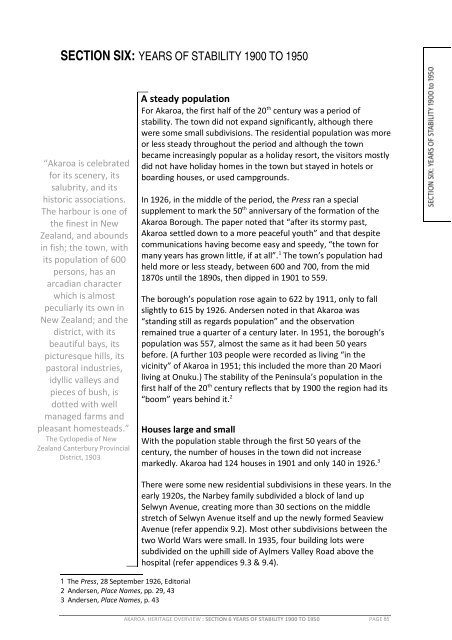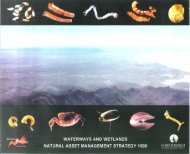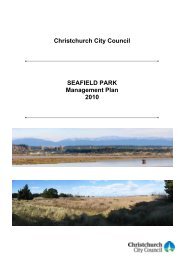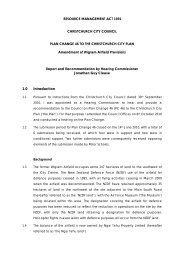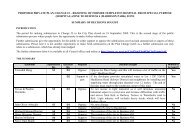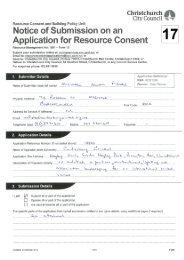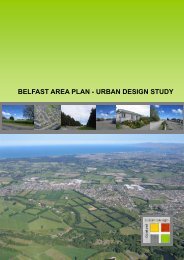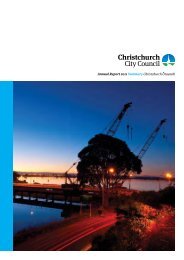Akaroa Historical Overview - Christchurch City Council
Akaroa Historical Overview - Christchurch City Council
Akaroa Historical Overview - Christchurch City Council
You also want an ePaper? Increase the reach of your titles
YUMPU automatically turns print PDFs into web optimized ePapers that Google loves.
SECTION SIX: YEARS OF STABILITY 1900 TO 1950<br />
“<strong>Akaroa</strong> is celebrated<br />
for its scenery, its<br />
salubrity, and its<br />
historic associations.<br />
The harbour is one of<br />
the finest in New<br />
Zealand, and abounds<br />
in fish; the town, with<br />
its population of 600<br />
persons, has an<br />
arcadian character<br />
which is almost<br />
peculiarly its own in<br />
New Zealand; and the<br />
district, with its<br />
beautiful bays, its<br />
picturesque hills, its<br />
pastoral industries,<br />
idyllic valleys and<br />
pieces of bush, is<br />
dotted with well<br />
managed farms and<br />
pleasant homesteads.”<br />
The Cyclopedia of New<br />
Zealand Canterbury Provincial<br />
District, 1903<br />
A steady population<br />
For <strong>Akaroa</strong>, the first half of the 20 th century was a period of<br />
stability. The town did not expand significantly, although there<br />
were some small subdivisions. The residential population was more<br />
or less steady throughout the period and although the town<br />
became increasingly popular as a holiday resort, the visitors mostly<br />
did not have holiday homes in the town but stayed in hotels or<br />
boarding houses, or used campgrounds.<br />
In 1926, in the middle of the period, the Press ran a special<br />
supplement to mark the 50 th anniversary of the formation of the<br />
<strong>Akaroa</strong> Borough. The paper noted that “after its stormy past,<br />
<strong>Akaroa</strong> settled down to a more peaceful youth” and that despite<br />
communications having become easy and speedy, “the town for<br />
many years has grown little, if at all”. 1 The town’s population had<br />
held more or less steady, between 600 and 700, from the mid<br />
1870s until the 1890s, then dipped in 1901 to 559.<br />
The borough’s population rose again to 622 by 1911, only to fall<br />
slightly to 615 by 1926. Andersen noted in that <strong>Akaroa</strong> was<br />
“standing still as regards population” and the observation<br />
remained true a quarter of a century later. In 1951, the borough’s<br />
population was 557, almost the same as it had been 50 years<br />
before. (A further 103 people were recorded as living “in the<br />
vicinity” of <strong>Akaroa</strong> in 1951; this included the more than 20 Maori<br />
living at Onuku.) The stability of the Peninsula’s population in the<br />
first half of the 20 th century reflects that by 1900 the region had its<br />
“boom” years behind it. 2<br />
Houses large and small<br />
With the population stable through the first 50 years of the<br />
century, the number of houses in the town did not increase<br />
markedly. <strong>Akaroa</strong> had 124 houses in 1901 and only 140 in 1926. 3<br />
1 The Press, 28 September 1926, Editorial<br />
2 Andersen, Place Names, pp. 29, 43<br />
3 Andersen, Place Names, p. 43<br />
There were some new residential subdivisions in these years. In the<br />
early 1920s, the Narbey family subdivided a block of land up<br />
Selwyn Avenue, creating more than 30 sections on the middle<br />
stretch of Selwyn Avenue itself and up the newly formed Seaview<br />
Avenue (refer appendix 9.2). Most other subdivisions between the<br />
two World Wars were small. In 1935, four building lots were<br />
subdivided on the uphill side of Aylmers Valley Road above the<br />
hospital (refer appendices 9.3 & 9.4).<br />
AKAROA HERITAGE OVERVIEW : SECTION 6 YEARS OF STABILITY 1900 TO 1950 PAGE 85


